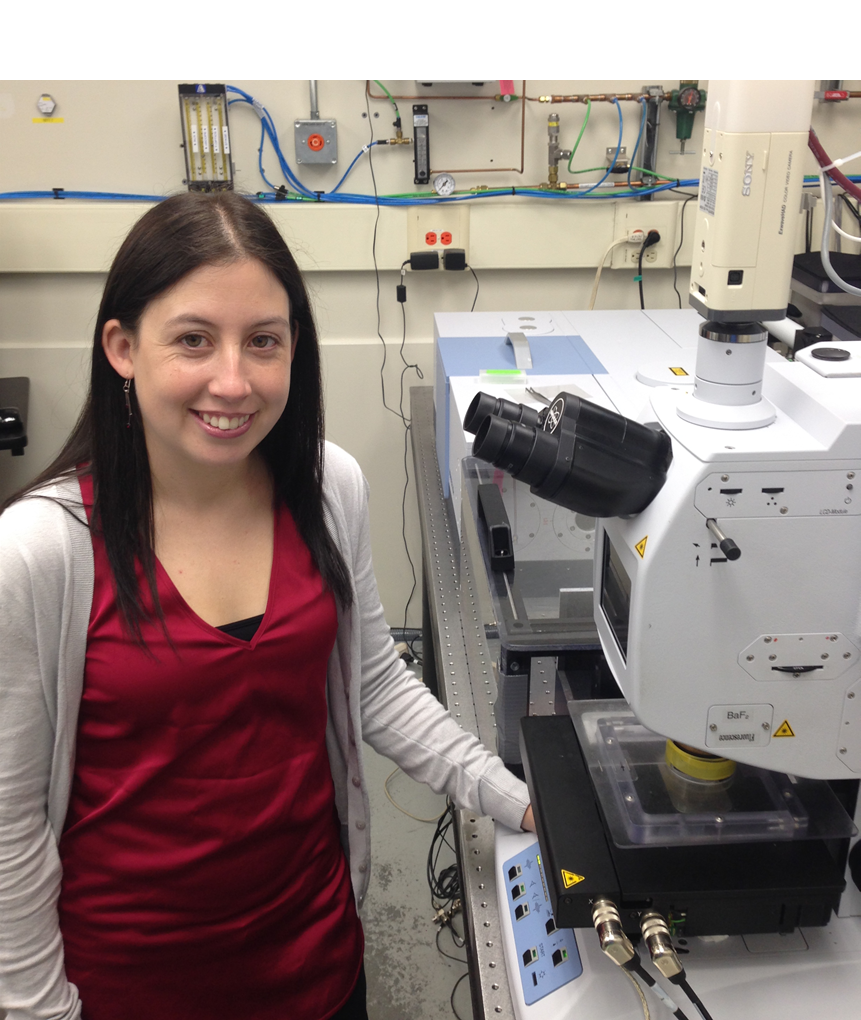
Trainee Spotlight
Dr. Sally Caine
Biography
In 2014, Dr. Sally Caine joined Dr. Phyllis Paterson’s research group as a postdoctoral fellow with the synchrotron medical imaging team funded through CIHR and Heart and Stroke Foundation of Canada. This followed a postdoctoral fellowship focused on tracking neural stem cells in a photothrombotic stroke model using gene expression mapping using synchrotron light (Project Leaders: Drs. Michael Kelly and Raphael Guzman).
Dr. Caine was also a trainee and a peer-elected member of the program executive committee for theCIHR Training Grant in Health Research Using Synchrotron Techniques. This program aims to bring together scientist and clinicians from a wide range of disciplines to train and mentor in the development and use of synchrotron techniques for health research. Dr. Caine obtained a Ph.D. in Chemistry and a Bachelor of Science with Honours from Monash University in Melbourne, Australia. During her Ph.D., Sally used synchrotron techniques to assess and understand chemical and structural changes in Multiple Sclerosis (MS) and MS‐like diseases.
Research
Dr. Caine’s current research uses novel synchrotron techniques in combination with standard biochemical, immunohistochemical, and functional analyses to understand the interaction between nutrition and rehabilitation efficiency after stroke. Protein-energy malnutrition is a frequent co-morbidity factor in stroke patients, with between 35-49% of patients presenting with it at admission to a rehabilitation setting. Despite the association of malnutrition with poorer patient outcomes, little is known about the effects of protein-energy malnutrition on adult brain plasticity and muscle atrophy following stroke and how this may impede rehabilitation-assisted recovery. The aim of this research is to use synchrotron techniques to image and quantify biochemical changes in the brain at higher resolution that conventional techniques, with the promise of uncovering the mechanisms behind optimal nutritional support for rehabilitation-assisted brain plasticity and recovery.
Publications
- Gagnon, K.B., Caine, S., Samadi, N., Martinson, M., van der Loop, M., Alcorn, J., Chapman, L.D., Belev, G., Nichol, H., 2015. Design of a mouse restraint for synchrotron-based computed tomography imaging. J Synchrotron Radiat 22, 1297-1300.
- MacDonald, T.C., Nehzati, S., Sylvain, N.J., James, A.K., Korbas, M., Caine, S., Pickering, I.J., George, G.N., Krone, P.H., 2015. Phenylthiourea alters toxicity of mercury compounds in zebrafish larvae. J Inorg Biochem 151, 10-17.
- Hackett, M.J., DeSouza, M., Caine, S., Bewer, B., Nichol, H., Paterson, P.G., Colbourne, F., 2015. A new method to image heme-Fe, total Fe, and aggregated protein levels after intracerebral hemorrhage. ACS Chem Neurosci 6, 761-770.
- Hackett, M.J., Caine, S., Liu, X., May, T.E., Borondics, F., 2015. Development of sngle‐beam wide‐field infrared imaging to study sub‐cellular neuron biochemistry. Vib spectroscopy 77,51‐59.
- Payne, N.L., Dantanarayana, A., Sun, G., Moussa, L., Caine, S., McDonald, C., Herszfeld, D., Bernard, C.C., Siatskas, C., 2012. Early intervention with gene-modified mesenchymal stem cells overexpressing interleukin-4 enhances anti-inflammatory responses and functional recovery in experimental autoimmune demyelination. Cell Adh Migr 6, 179-189.
- Song, B., Sun, G., Herszfeld, D., Sylvain, A., Campanale, N.V., Hirst, C.E., Caine, S., Parkington, H.C., Tonta, M.A., Coleman, H.A., Short, M., Ricardo, S.D., Reubinoff, B., Bernard, C.C., 2012. Neural differentiation of patient specific iPS cells as a novel approach to study the pathophysiology of multiple sclerosis. Stem Cell Res 8, 259-273.
- Caine, S., Heraud, P., Tobin, M.J., McNaughton, D., Bernard, C.C., 2012. The application of Fourier transform infrared microspectroscopy for the study of diseased central nervous system tissue. Neuroimage 59, 3624-3640.
- Heraud, P., Ng, E.S., Caine, S., Yu, Q.C., Hirst, C., Mayberry, R., Bruce, A., Wood, B.R., McNaughton, D., Stanley, E.G., Elefanty, A.G., 2010. Fourier transform infrared microspectroscopy identifies early lineage commitment in differentiating human embryonic stem cells. Stem Cell Res 4, 140-147.
- Heraud*, P., Caine*, S., Campanale, N., Karnezis, T., McNaughton, D., Wood, B.R., Tobin, M.J., Bernard, C.C., 2010. Early detection of the chemical changes occurring during the induction and prevention of autoimmune-mediated demyelination detected by FT-IR imaging. Neuroimage 49, 1180-1189.*Co-first authors.
- Heraud, P., Caine, S., Sanson, G., Gleadow, R., Wood, B.R., McNaughton, D., 2007. Focal plane array infrared imaging: a new way to analyse leaf tissue. New Phytol 173, 216-225
